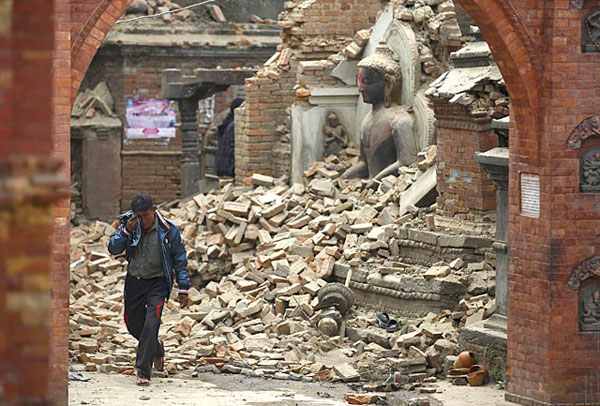Crisis loomed over quake-hit Nepal on Monday following shortage of food, water, electricity and medicines as fear drove tens of thousands of people out into the open and the death toll crossed 4,000.
Aid flights arrived through the day carrying emergency medical teams, search-and-rescue equipment and tarps for shelter, but everything seemed to be in short supply in capital Kathmandu and other affected areas.
More than two days after the quake struck, people searched for lost loved ones, sorted through rubble for their belongings and struggled to provide for their families’ needs.
Tens of thousands of families were camped in the streets and in open parks, sleeping inside plastic tents as powerful aftershocks continued to rock the region every few hours.
“We have become refugees,” said Sarga Dhaoubadel, a student whose ancestors had built her Bhaktapur family home over 400 years ago. They were subsisting on instant noodles and fruit.
Nepal police said on their Facebook page that the death toll in the country from Saturday’s 7.9 magnitude earthquake had risen to 3,904 people, with 7180 injured. This does not include the deaths in India, the 25 people killed in Tibet and the 18 people killed in the avalanche on Mount Everest.
The death toll in India from the quake shot up to 72 with 56 deaths reported in Bihar, 12 in UP, three in West Bengal and one in Rajasthan.
India led international salvage and evacuation efforts as teams with sniffer dogs and metal-cutters raced to find survivors buried in the rubble, though the possibility of pulling out someone alive slimmed considerably two days after the monster quake hit the Himalayan nation.
“We will continue to look for survivors as long as possible,” said Nepal home ministry spokesperson Laxmi Prasad Dhakal, underscoring the resolve of a nation trying to pick up the pieces after its biggest tragedy in 80 years.
As rescue workers reach out to remote villages which have been inaccessible since the quake, the country’s officials expressed fears the toll would go up to 5,000.
“There are people who are not getting food and shelter. I’ve had reports of villages where 70 percent of the houses have been destroyed,” said Udav Prashad Timalsina a top official in Gorkha district where the quake was centred.
Aid is coming from more than a dozen countries and many charities, but Lila Mani Poudyal, the government’s chief secretary and the rescue coordinator, said Nepal needed more.
“We urge foreign countries to give us special relief materials and medical teams. We are really desperate for more foreign expertise to
pull through this crisis,” he said.
“We are appealing for tents, dry goods, blankets, mattresses, and 80 different medicines that we desperately need now,” he told a press conference.
As people are pulled from the wreckage, he noted, even more help is needed.
“Now we especially need orthopaedic (doctors), nerve specialists, anaesthetists, surgeons and paramedics,” he said. “We are appealing to foreign governments to send these specialised and smart teams.”
Dozen countries help Nepal
Help was pouring into Nepal from across the world, as countries big and small sent in medical and rescue teams to provide disaster relief.
A Nepal army spokesman says rescue workers and medical teams from at least a dozen countries were in Nepal helping local police and army rescuers.
Maj. Gen. Binod Basnyat said the teams were in different places in Kathmandu and surrounding areas. India has sent the biggest team with six helicopters and seven trucks.
Seven Indian search and rescue teams and another seven medical teams were at work Monday in the worst-hit areas. They had rescued 10 people and recovered 40 bodies from the rubble of fallen buildings in different parts of Kathmandu.
China has sent a medical team and a team of experts to move through structures destroyed in the quake and help with search and rescue operations. Chinese doctors have set up a field hospital at the mountain resort town of Dhulikhel, 30 kilometers (18 miles) east of Kathmandu.
Two teams of US Army green beret soldiers who happened to be in Nepal when the deadly earthquake struck Saturday,are staying to help with search and relief efforts
Even Nepal’s tiny Himalayan neighbor, Bhutan, has sent a medical team to help the survivors of the quake.
Medical and rescue teams from Russia, Japan, France, Switzerland and Singapore were expected to arrive in Kathmandu over the next couple of days, the army said.
Mass cremations
Mass cremations were held in Kathmandu for the victims, even as rescuers continued to pull out bodies buried under the rubble of flattened homes and buildings.
Hundreds were cremated in open grounds as funeral pyres burned with families of victims wailing in grief after losing their loved ones.
Almost every available space along the Bagmati river’s banks and on its sandbank islands had been taken by the pyres.
Around these funerals, the families, hastily assembling their piles of wood, gathered. The smoke rose and floated over the city ravaged by the ugly devastation of the 7.9-magnitude quake.
Kathmandu shifted 3 metres?
Initial analysis of seismological data show that capital Kathmandu may have shifted about three metres (10 feet) southward, said University of Cambridge tectonics expert James Jackson.
An area of about 150 kilometres (93 miles) long and 50 km wide in a fault running underneath the Kathmandu valley, gave in after decades of pressure, causing rocks on top of the fault to slip southward over the rock underneath it.
The shifts may be large enough to necessitate adjustments to high-precision world maps.

